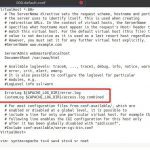Part of your job as a programmer is to track bugs, find errors, or just check some backend results.
Some people find it hard to use the debuggers or they can’t be installed remotely. So you can choose this small cheat to do this job.
This can be done by manipulating and watching the log files of your Web server.
In the Apache web server, you can configure your own error log files. You can set different error logs for your different virtual hosts
The simplest command to watch it in real-time is by typing in the console:
tail -f /var/log/apache2/error.log
(This is the default Apache logs path)
Extended version
To use the extended version you have to add this row in your code:
error_log(print_r('<track_word> '$var_to_print.json_encode(, JSON_PRETTY_PRINT | JSON_UNESCAPED_UNICODE | JSON_UNESCAPED_SLASHES),1));
You must set the same ‘track_word’ in both places.
We use json_encode because we have to convert all the objects or arrays to log-compatible look
tail -f /var/log/apache2/wherror.log | grep --line-buffered <track_word> | sed 's/\\n/\n/g'
Paste the code above in the console and run your PHP code. Enjoy
Views: 59

